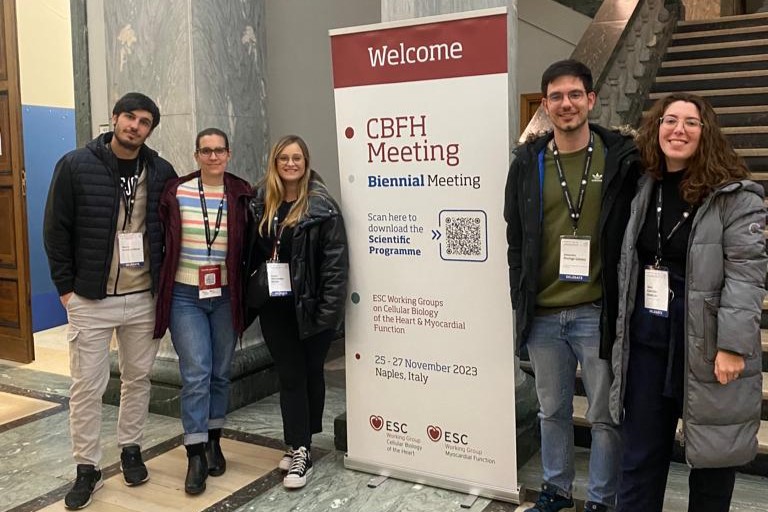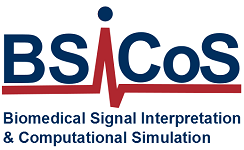19 December, 2023
A group of researchers from the BSiCoS group has participated in the Biennial Meeting ESC Working Groups on Cellular Biology of the Heart & Myocardial Function. The meeting took place in Naples (Italy) from November 25 to 27 and works presented there were:

Laura García: Progerin is an unlikely contributor to natural cardiac aging, but promotes age-related phenotypes in vitro
Ageing effects in the heart are observed at several levels: functional, structural, cellular, and molecular. In human, main functional and structural age-related changes are well characterised. However, the molecular and cellular mechanisms that modulate them are largely based on animal studies (with translation limitations) or cross-sectional population studies (affected by high inter-individual variability). Relevant models to study these mechanisms longitudinally in humans are lacking. Hutchinson-Gilford progeria syndrome (HGPS) is an extremely rare genetic disorder characterised by accelerated ageing. HGPS is caused by the expression of a truncated form of lamin A, progerin, resulting from cryptic splicing. Patients with HGPS present cardiovascular alterations that resemble those of natural ageing. Although progerin has been reported to be expressed in several aged human tissues, its cardiac expression in natural ageing and its ability to induce ageing of human cardiac cells remains to be assessed. These are the aims of this study. We evaluated the expression of LMNA gene and progerin mRNA in the human left ventricle (LV). We also generated a transgenic human iPSC line and characterised phenotypic changes caused by the inducible expression of progerin in committed cardiomyocytes. Finally, we compared our in vitro model with cross-sectional human transcriptomic data. LMNA and progerin mRNA expression appeared to increase similarly with age in the human LV. This suggests that natural ageing is not associated with a shift towards the pathological transcript variant. However, in committed hiPSC-derived cardiomyocytes, inducible expression of progerin led to the recapitulation of ageing hallmarks and transcriptomic changes present in the human LV. Progerin is unlikely to be a major inducer of natural cardiac ageing, but may promote ageing features in vitro.
Longitudinal mechanistic studies of human cardiac cell ageing (or in other cell lineage) can be advanced with this groundbreaking accelerated ageing tool.
Natalia Hernández: Identification of biological age indicators as potential predictors of physical and cardiac-related conditions
Ageing stands as a main predisposing risk factor for numerous diseases, including cardiovascular diseases (CVD). Extensive research has delved into the ageing role in CVD, however, variable ageing rates mean chronological age (CA) may not always provide a precise insight into an individual´s physiological condition. Age-related biological indicators, influenced by genetics and environmental factors over time, could provide a more accurate explanation. Consequently, assessing the influence of age on cardiac function raises the necessity for purposeful biological age (BA) indicators for predicting age-related cardiovascular risk. This study aims to establish individual (BAind) and cardiac-specific BA (BAcardiac) indices and present proof-of-concept of their ability to discriminate between individuals’ physical and cardiac condition.
Marcos Sánchez: Exploiting the therapeutic potential of microRNAs and DNA nanotechnology to create novel cardioregenerative treatments.
Background: Myocardial infarction, if not fatal, can lead to remodelling of the cardiac tissue and progression to heart failure. Currently no effective therapy to prevent this pathological process exists. MicroRNAs (miR), i.e. miR-199a-3p, have been reported to promote cardiac regeneration after infarction by stimulating cardiomyocyte proliferation. Here we propose to exploit this capacity to develop cutting-edge miR nanotherapies. DNA nanostructures (DNS) capable of carrying and delivering miR-199a-3p are created and characterised.
Elisa Garrido: High-content phenotypic profiling to advance the maturation state of human induced pluripotent stem cells derived cardiomyocytes
Human induced pluripotent stem cells-derived cardiomyocytes (hiPSC-CMs) have a great potential for disease modelling and thus, for developing new treatments. However, their use is hampered by their immature estate. Here, we have developed methods for advanced image-based phenotypic profiling of hiPSC-CMs to investigate the effect of different 2D maturation strategies. The ultimate goal is to elucidate the most time and cost-effective approach to obtain mature hiPSC-CMs.
Regular and epigenetically primed using pIC (EP) differentiated progenies with >90% TNNT2+ hiPSC-CMs were cultured on regular plates or on PDMS sheets (to imitate the stiffness of the heart) for 8 days. These cultures were maintained either in cardiomyocyte maintenance media (CMM) or in maturation medium (MM). MM contained hormones and factors that pike naturally after birth (T3, and corticoids and IGF-1α) and a factor to provoke a metabolic switch from glycolysis to β-oxidation (as occurs postnatally). Methods were developed to phenotypically characterise the degree of maturation of the cultures using high content imaging (HCI) snd analysis techniques.
Previously existing deep-learning based tools have been optimized to automatically segment multinucleated cardiomyocytes. Also, the staining of several structural, functional and maturation markers have been optimized. With this, a dataset of 12,480 images has been single-cell analysed using user-defined feature extraction methods (CellBlocks). UMAP and PCA analysis show variability among biological replicates that better explains the differences found by the phenotypic features than the different conditions. The combination of EP with MM seems however to yield the more consistent effects in maturation, clustering on UMAP far from the baseline condition, and achieving an increase on TNNI3, a well-known maturation marker.
Beyond the robust commitment of hiPSC-derived cardiac progenies as TNNT2+cardiomyocytes, HCI analysis highlights an interexperimental phenotypic heterogeneity of hiPSC-CM that combinatorial maturation approaches might contribute to reduce while promoting maturation.
